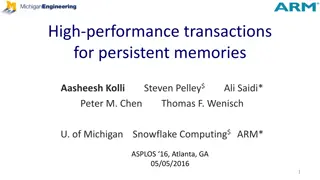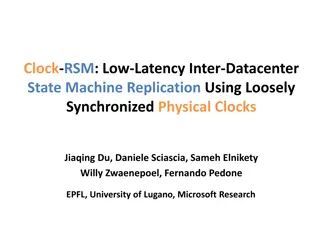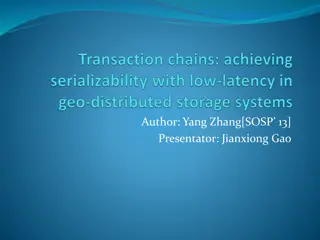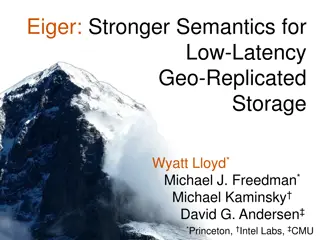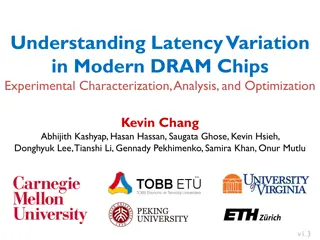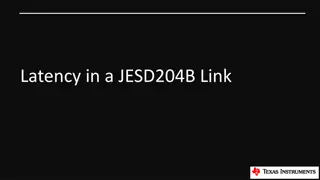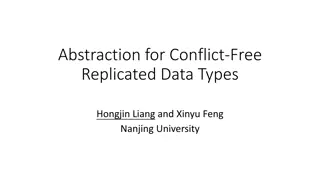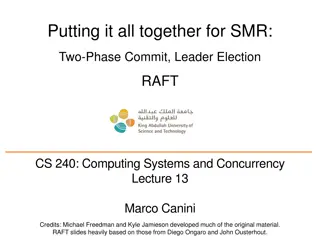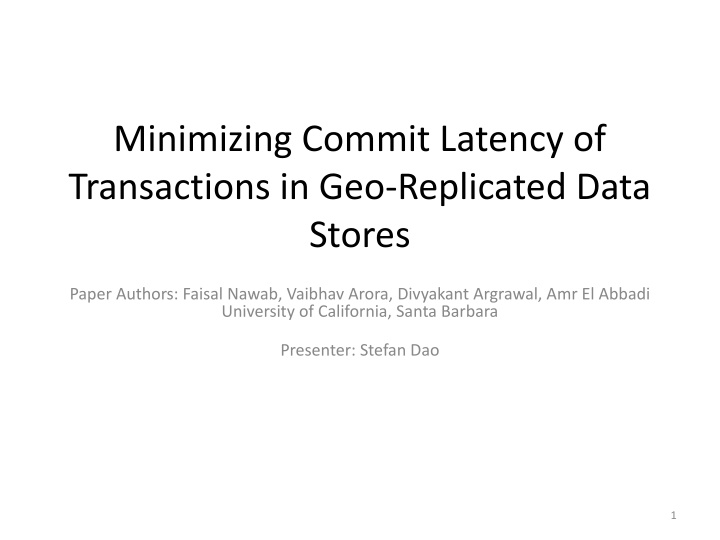
Optimizing Commit Latency in Geo-Replicated Data Stores
Explore strategies to minimize commit latency in geo-replicated data stores, focusing on the importance of low latency for efficient transactions. The paper delves into challenges faced by data centers, related works in the field, and an in-depth analysis of the Helios algorithm for achieving lower commit latency.
Download Presentation

Please find below an Image/Link to download the presentation.
The content on the website is provided AS IS for your information and personal use only. It may not be sold, licensed, or shared on other websites without obtaining consent from the author. If you encounter any issues during the download, it is possible that the publisher has removed the file from their server.
You are allowed to download the files provided on this website for personal or commercial use, subject to the condition that they are used lawfully. All files are the property of their respective owners.
The content on the website is provided AS IS for your information and personal use only. It may not be sold, licensed, or shared on other websites without obtaining consent from the author.
E N D
Presentation Transcript
Minimizing Commit Latency of Transactions in Geo-Replicated Data Stores Paper Authors: Faisal Nawab, Vaibhav Arora, Divyakant Argrawal, Amr El Abbadi University of California, Santa Barbara Presenter: Stefan Dao 1
Latency Definition: Time interval between stimulation and response Why is it important? Low latency means more $$$ 2
Datacenters Challenges DCs must be resilient to disruptions Solution? Replication but it s expensive! High level of consistency More sent messages Higher latency! Replication 3
Related Work Cassandra, Dynamo (Geo-replication) Megastore, Paxos-CP (Serializability) Message Futures (Low Latency) Spanner, Orbe, GentleRain (Clock Synchronization) RAMCloud (Distributed Shared Log) 4
Helios Serializable Transactions Geo- Low latency replicated Loosely Synchronized Clocks Log Replication 5
Lower-Bound on Commit Latency Commit Latency (Lx) Summation of latencies between datacenters must be greater than or equal to round trip time (RTT) 6
Optimal Latency Minimum Average Optimal latency (MAO) Linear equation to minimize LA Subject to LA + LB > RTT(A,B) LA > 0 7
Helios Cont. N x N time table Ex. TA[B, C] = t1 Commit offsets Ex. (coAB) Knowledge Timestamps (kts) ktstB = q(t) + coAB 8
Helios Algorithm (Commit Request) Check for conflicts Transaction T PT Pool EPT Pool Read Set 9
Helios Algorithm (Commit Request) PT Pool EPT Pool Check if overwritten Transaction T Read Set 10
Helios Algorithm (Commit Request) PT Pool EPT Pool Add to PTPool Read Set Get t.ktst of all datacenters Transaction T 11
Helios Algorithm (Log Processing) Check for conflicts (and not local) Transaction T PT Pool EPT Pool Data Store Time Tables 12
Helios Algorithm (Log Processing) PT Pool If T is preparing, append Transaction T EPT Pool Data Store Time Tables 13
Helios Algorithm (Log Processing) PT Pool Either way, remove from EPT Pool EPT Pool Transaction T Data Store If T is finished and committed, write to datastore Time Tables 14
Helios Algorithm (Log Processing) PT Pool EPT Pool Data Store Update time tables with timestamp Transaction T Time Tables 15
Helios Algorithm (Committing Preparing Transactions) PT Pool Transaction T Data Store If time > t.kts, commit and log the commit 16
Liveness of Helios We want our system to be robust to failures! How? Allow up to f failures within the system Wait on commits for f responses Utilizes time-based invalidation (Grace Time) Invalidates transactions after GT Grace Time has tradeoffs Increased latency Small Grace Time vs Large Grace Time 17
Liveness Cont. B A C 18
Liveness Cont. B A C 19
Liveness Cont. B A Helios-1 : A needs confirmation from C before it can commit C 20
Liveness Cont. Transactions from B before failure are invalidated B A C 21
Evaluation Paper evaluates the following: How does Helios perform relative to existing systems (latency, throughput, abort rate)? (Message Futures, Replicated Commit, 2PC/Paxos) What are the effects of poor clock synchronization? What are the effects of poor RTT estimation? 22
Evaluation Experiment Setup 60 clients with 5 distinctly geo-located datacenters Running regular instances of Helios 23
Evaluation Experiment Setup Increasing number of clients to see the effects on throughput, latency, and abort percentage of each system 24
Evaluation Experiment Setup Vary clock Virginia datacenter by -100/+100 ms Vary clock on each datacenter by set amount 25
My Thoughts! Paper was very easy to follow Thoughtful experimentation! Utilized Zipf distribution for data store access. Addressed issues such as scalability In terms of latency not the best system but performs well overall 26
Discussion: Minimizing Commit Latency of Transactions in Geo-Replicated Data Stores Scribed by Jen-Yang Wen
Summary Feature: Low latency serializable transactions on geo-replicated data stores Technique: Timestamps by local loosely synchronized clocks Shared Log Optimizing average commit latency by linear programming Configurable f-resilient Evaluation: On Amazon AWS with 5 geo-replicated data centers
Discussion Pros: High performance Novel theory, proof, and protocol Flexibility Separate serializability from liveness Able to manual tuning parameters Evaluation on AWS geo-replicated systems Use shared log for higher stability Extensive analysis Well organized
Discussion Pros: High performance Novel theory, proof, and protocol Flexibility Separate serializability from liveness Able to manual tuning parameters Evaluation on AWS geo-replicated systems Use shared log for higher stability Extensive analysis Well organized Cons: Irrealistic assumptions Performance sensitive to clock sync. Not the best in all the three evaluation aspects Experiment only over 10 mins Proof not formal Liveness and commit latency tradeoff Tedious configuration process No test under failure Focus on average, not tail latency Storage overhead of the full copy shared logs Limited discussion on Grace Time/ f- value
Questions A quick poll: Does the Proof of lower-bound seem formal to you? Different servers have different commit speed, a good idea? It would be interesting to see how multiple applications running on cloud platform and requiring different average commit latencies can be handled. Any additional questions or comments?










